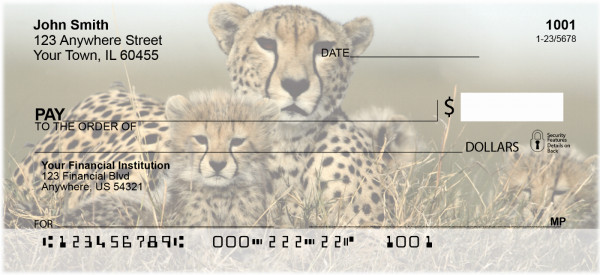Buy personal checks with Big Cat Babies designs

 Big Cat Babies Personal Checks – $22.99 These Big Cat Babies Checks depict the cuter side of the vicious meat eating cats of the wild. With four rotating images of these little baby cats, these checks are sure to make you smile. |
Introduction to Big Cat Babies
The world of big cats is as intriguing as it is diverse, with each species boasting its own unique characteristics and charm. One thing that unites all these cats is the undeniable appeal of their young. From lion cubs to tiger kittens, big cat babies captivate us with their adorable appearance and playful antics.
In this piece, we’ll explore the fascinating world of these cats, their development, and the challenges they face in the wild.
The Early Life of Lion Cubs
Lion cubs, born in litters of one to six, are entirely reliant on their mothers for the first few weeks of their lives. They are born blind, gaining their sight after about a week, and remain hidden from the pride in a secluded den. Around six to eight weeks of age, lion cubs are introduced to the pride, where they learn to socialize and play with their siblings and other pride members. As they grow, lion cubs practice their hunting skills through play, preparing them for their future role as a hunter within the pride.
Tiger Cubs: Growing Up in the Wild
Tiger cubs, usually born in litters of two to four, face a challenging journey from birth to adulthood. They are born blind and rely on their mother’s care and protection. Tiger cubs are introduced to meat at around two months old and begin accompanying their mother on hunts at six months. As they grow, tiger cubs learn essential survival skills, such as stalking and ambushing prey, before they eventually leave their mother to establish their own territories at around two years of age.
The Playful World of Leopard Cubs
Leopard cubs are born in litters of one to six, with their eyes closed for the first week or so. Once they are strong enough, leopard cubs follow their mother as she hunts, observing her techniques and practicing their own skills. As solitary animals, leopards must learn to fend for themselves from a young age. Leopard cubs typically stay with their mother for around 18 months to two years, learning essential survival skills before venturing off on their own.
Adventures of Jaguar Kittens
Jaguar kittens, born in litters of one to four, are born blind and helpless. Their mother keeps them hidden in a den, providing them with care and protection during their first few months. As they grow, jaguar kittens accompany their mother on hunts, learning crucial hunting techniques and survival skills. Jaguar kittens remain with their mother for about two years before they leave to establish their own territories.
Challenges Faced
Big cat babies, like all young animals, face numerous challenges in their journey to adulthood. The most significant threats they face are predation and competition for resources. In the case of lions, for example, rival males taking over a pride may kill existing cubs to establish their own lineage. Similarly, tiger cubs face threats from other tigers and various predators in their environment.
Human activity also poses a significant threat to big cat babies. Habitat loss, poaching, and human-wildlife conflict are all factors that impact the survival of these incredible animals. Conservation efforts are essential to ensure the continued existence of these cats and their young in the wild.
Role of Zoos and Wildlife Sanctuaries
Zoos and wildlife sanctuaries play a crucial role in big cat conservation, providing safe environments for breeding and raising young. These facilities also serve as educational resources, raising awareness about the plight of these cats and their habitats. By supporting conservation-focused zoos and sanctuaries, we can contribute to the preservation of big cats and their babies for generations to come.
The Importance of Cats in the Ecosystem
Big cat babies are essential to maintaining the balance of ecosystems in which they reside. As they grow into adults, these animals play a vital role as top predators, helping to control populations of herbivores and smaller predators. This, in turn, has cascading effects throughout the ecosystem, influencing plant growth, nutrient cycling, and the overall health of their habitats.
Rehabilitation and Release Programs
Rehabilitation and release programs play a significant role in the conservation of big cats. These programs rescue orphaned or injured cats, provide them with the necessary care and medical attention, and prepare them for life in the wild.
Once the young cats have developed the skills they need to survive, they are released back into their natural habitat, contributing to the overall population and genetic diversity of their species.
Conservation Efforts
Conservation efforts focused on big cat babies have a far-reaching impact on the overall health and stability of big cat populations. By protecting these young animals and ensuring their successful transition to adulthood, we can bolster the future of these cat species and preserve these majestic creatures for generations to come.
Fostering
To ensure the future of big cat babies, it’s crucial to foster a love and appreciation for these animals and their conservation. Educating ourselves and others about the challenges they face and supporting organizations dedicated to their preservation can make a significant difference in the fight to save these remarkable creatures.
Conclusion
Big cat babies, with their undeniable charm and charisma, inspire awe and wonder in all who encounter them. By understanding their unique needs and challenges, we can work together to protect these incredible animals and ensure their survival in the wild. Through education, conservation, and shared love for these magnificent creatures, we can help secure a brighter future for these cats and the ecosystems they inhabit.